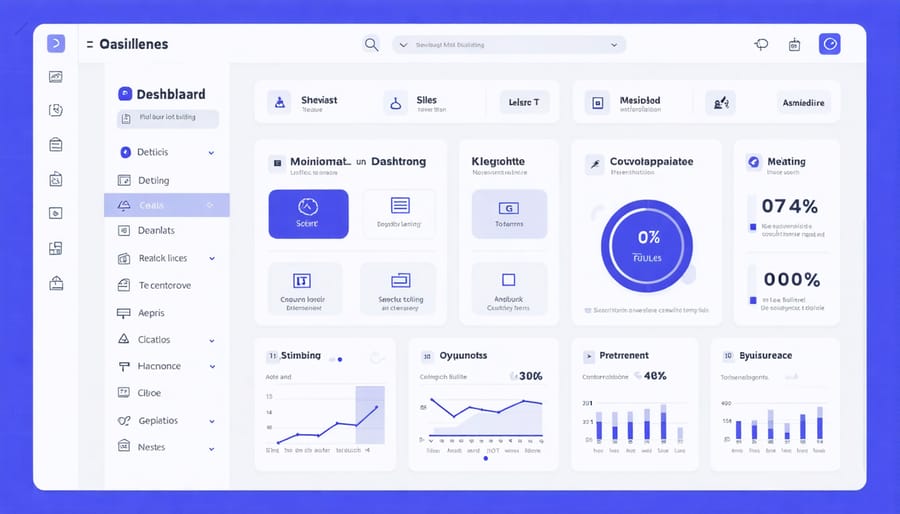As technology reshapes the real estate landscape, traditional insurance models are giving way to dynamic, data-driven solutions that protect against emerging risks. From AI-powered property management systems to IoT-enabled smart buildings, these new technologies demand innovative insurance frameworks that adapt in real-time.
Emergent insurance solutions leverage advanced analytics, blockchain technology, and parametric triggers to offer property owners unprecedented protection against both conventional and tech-related risks. These new models don’t just react to claims—they actively predict, prevent, and mitigate potential losses through continuous monitoring and automated risk assessment.
Consider how a modern smart building’s insurance needs differ from traditional coverage: cyber threats to building management systems, data breach vulnerabilities, and IoT device malfunctions all require specialized protection that simply didn’t exist a decade ago. Today’s emergent insurance solutions address these challenges through hybrid policies that combine traditional property coverage with technology-specific protections.
For property owners and managers navigating this evolving landscape, understanding these new insurance paradigms isn’t just about risk management—it’s about staying competitive in a rapidly digitalizing market. The right emergent insurance solution can transform potential technological vulnerabilities into opportunities for enhanced operational efficiency and reduced long-term costs.
The New PropTech Landscape: Evolving Insurance Needs
Smart Building Systems
As smart building systems become increasingly prevalent, insurance considerations for these technologies have evolved significantly. Recent property technology insurance trends indicate a growing need for specialized coverage protecting IoT devices, automated systems, and smart home technologies.
Insurance providers now offer policies specifically designed to address risks associated with smart building components, including cyber threats, system malfunctions, and data breaches. These policies typically cover damages resulting from smart device failures, such as water damage from malfunctioning smart water systems or security breaches in automated access controls.
Key considerations for property owners include coverage for:
– Network security and data protection
– Smart device replacement and repair
– Business interruption due to system failures
– Third-party liability for privacy breaches
– Professional liability for system installers
When selecting coverage, property owners should evaluate their smart system’s complexity, potential vulnerabilities, and the value of connected assets. Many insurers now offer risk assessment tools specifically designed to evaluate smart building systems, helping property owners identify potential gaps in coverage and implement appropriate risk management strategies.

Virtual and Augmented Reality
Virtual and augmented reality technologies are revolutionizing property showings and management, creating new insurance considerations for real estate professionals. Virtual property tours now allow potential buyers to explore homes remotely, while AR tools enable property managers to visualize maintenance issues and planned improvements in real-time.
These technological advances, while beneficial, introduce unique liability risks. Insurance providers are developing specialized coverage options that protect against virtual showing mishaps, such as data breaches during virtual tours or errors in AR-based property measurements. Coverage typically includes protection against cyber incidents, professional liability for virtual staging errors, and potential claims arising from AR-based property management decisions.
Key insurance considerations include coverage for virtual tour platform malfunctions, protection against privacy breaches during remote showings, and liability coverage for AR-tool accuracy. Property managers should also ensure their policies cover potential damages resulting from AR-guided maintenance work or renovation planning.
As these technologies become more prevalent, insurance solutions are evolving to include specific riders for VR/AR applications, ensuring comprehensive protection for both traditional and tech-enhanced real estate operations.
Innovative Insurance Products for Modern Real Estate

Cyber Liability Coverage
In today’s digital age, protecting your real estate investments goes beyond physical security. With smart home systems, digital transactions, and cloud-based property management platforms becoming the norm, cybersecurity threats in real estate have emerged as a significant concern for property owners and managers.
Cyber liability coverage specifically designed for real estate technology addresses vulnerabilities in smart building systems, digital payment platforms, and tenant data management systems. This insurance typically covers costs associated with data breaches, including notification expenses, legal fees, and reputation management services.
Key aspects of cyber liability coverage include protection against:
– Unauthorized access to smart home systems
– Theft of tenant or property management data
– Ransomware attacks targeting building automation systems
– Business interruption due to cyber incidents
– Third-party claims resulting from data breaches
When selecting cyber liability coverage, consider the scope of your property’s technology integration. Basic policies might cover data breach response, while comprehensive plans include coverage for system restoration, cyber extortion, and business income loss during system downtimes.
Insurance providers are increasingly offering tailored packages that combine traditional property coverage with cyber protection, recognizing the growing intersection between physical assets and digital infrastructure in modern real estate operations.
Technology Error & Omissions
In today’s tech-driven real estate landscape, protecting against digital mishaps is crucial. Technology errors and omissions coverage has emerged as an essential safeguard for property professionals utilizing PropTech solutions. This specialized insurance addresses the unique risks associated with software malfunctions, data breaches, and technology service failures that traditional policies might not cover.
The coverage typically extends to scenarios like smart home system failures, property management software glitches, and automated payment processing errors. For instance, if a smart security system malfunction leads to unauthorized access or property damage, this insurance helps cover the resulting losses and potential legal expenses.
Property professionals should consider coverage limits that align with their technology implementation scope. Key factors include the number of connected devices, complexity of automated systems, and potential financial impact of tech-related failures. The policy should also address third-party vendor relationships, as many modern real estate operations rely on external technology providers.
Common claim scenarios include smart thermostat malfunctions leading to property damage, automated lease management system errors causing financial losses, and building automation failures affecting multiple units. By securing appropriate coverage, real estate professionals can confidently embrace innovative technologies while maintaining robust risk management practices.
Usage-Based Insurance Models
Usage-based insurance (UBI) models are revolutionizing property coverage by aligning premiums with actual technology utilization and risk patterns. Instead of fixed annual premiums, property owners can now opt for flexible insurance solutions that adjust based on how they use and maintain their smart home systems and PropTech installations.
These innovative models leverage data from connected devices, such as smart thermostats, security systems, and water leak detectors, to assess risk in real-time. For example, properties equipped with advanced monitoring systems that demonstrate consistent maintenance and quick response to potential issues may qualify for lower premiums.
The pricing structure typically follows a “pay-as-you-use” framework, where premiums fluctuate based on several factors:
– Active usage of smart security systems
– Regular maintenance of connected devices
– Response time to system alerts
– Overall property technology performance metrics
For property managers and owners, this means more control over insurance costs and incentives for maintaining efficient property technology systems. Some insurers offer additional discounts for properties that implement preventive measures through IoT devices or demonstrate improved risk management through technology adoption.
This shift towards usage-based models represents a win-win situation: property owners benefit from more accurate pricing and potential savings, while insurers can better assess and manage risks through real-time data analytics. As PropTech continues to evolve, these insurance models are expected to become increasingly sophisticated and personalized.
Risk Assessment in the Digital Age
AI-Driven Risk Analysis
In today’s rapidly evolving real estate landscape, insurers are leveraging artificial intelligence to revolutionize how they evaluate property risks. Through AI-powered risk assessment, insurance companies can now analyze vast amounts of data from multiple sources, including IoT sensors, smart home devices, and historical claims data, to create more accurate risk profiles for properties.
These AI systems excel at identifying patterns and potential issues that human assessors might miss. For instance, they can detect correlations between certain smart home installations and reduced incident rates, or flag properties with higher-than-average technology-related vulnerabilities. This comprehensive analysis helps insurers offer more personalized coverage options and more accurate premium calculations.
The AI algorithms also continuously learn from new data, improving their accuracy over time. They can predict potential issues before they occur by analyzing factors such as device maintenance patterns, usage data, and environmental conditions. This predictive capability allows property owners to take preventive measures while enabling insurers to provide more proactive risk management advice.
For property owners and managers, this technological advancement means more transparent and fair insurance pricing. Properties with well-maintained smart systems and proper cybersecurity measures in place often qualify for better rates, creating a direct financial incentive for implementing and maintaining modern property technologies responsibly.

Real-Time Monitoring Benefits
Real-time monitoring systems are revolutionizing how insurance companies assess and price property coverage. By implementing continuous monitoring solutions, property owners can now benefit from more accurate premium calculations that reflect their actual risk levels rather than broad demographic assumptions.
These monitoring systems track various property conditions, from water leaks and HVAC performance to security breaches and structural integrity. Insurance providers increasingly offer substantial premium discounts – often ranging from 5% to 15% – for properties equipped with smart monitoring devices. This technology not only helps prevent costly damages but also enables faster response times when incidents occur.
The benefits extend beyond just cost savings. Property owners gain access to detailed analytics about their building’s performance, helping them identify potential issues before they become major problems. Insurance companies can provide more tailored coverage options based on actual usage patterns and risk factors, leading to more flexible and comprehensive policies.
For example, a smart water detection system that immediately alerts property managers to leaks can prevent extensive water damage, potentially saving thousands in repairs and avoiding premium increases. Similarly, real-time security monitoring can lead to lower theft-related premiums and faster claim processing when incidents occur.
The data collected through continuous monitoring also strengthens the relationship between insurers and property owners, creating a more collaborative approach to risk management and property protection. This partnership often results in better coverage terms and more efficient claim resolution processes.
Future-Proofing Your Property Insurance
As the PropTech landscape evolves, future-proofing your property insurance becomes increasingly crucial. Start by conducting a comprehensive technology audit of your property, documenting all smart systems, IoT devices, and automated features. This inventory will serve as your foundation for selecting appropriate coverage.
When evaluating insurance policies, look for providers who offer specialized technology endorsements or riders. These additions should specifically address risks like cyber threats, data breaches, and smart system malfunctions. Consider policies that include coverage for business interruption due to technology failures, as these can significantly impact property operations and revenue.
Stay ahead by implementing a regular policy review schedule, ideally every six months, to ensure your coverage aligns with your property’s technological evolution. As you integrate new smart systems or automation features, immediately notify your insurance provider to avoid coverage gaps.
Consider these practical steps for maintaining robust coverage:
1. Document all software updates and maintenance procedures
2. Keep detailed records of technology installations and warranties
3. Establish clear protocols for cybersecurity measures
4. Maintain relationships with qualified tech maintenance providers
5. Create contingency plans for system failures
Work with insurance providers who demonstrate knowledge of emerging property technologies and offer scalable solutions. Look for policies that include provisions for technology upgrades and adaptations, ensuring your coverage can evolve alongside your property’s capabilities.
Consider investing in supplementary coverage options like cyber liability insurance and equipment breakdown protection. These additional layers of security can prove invaluable as your property’s technological complexity increases.
Remember to factor in future technology trends when selecting coverage terms. Policies with flexible terms and the ability to accommodate new technologies without major revisions will save time and money in the long run.
Lastly, establish a network of technology and insurance professionals who can provide ongoing guidance. Regular consultations with these experts will help you anticipate coverage needs and adapt your insurance strategy proactively rather than reactively.
As PropTech continues to reshape the real estate landscape, insurance solutions are evolving to meet the unique challenges and opportunities presented by technological innovation. The emergence of data-driven risk assessment, IoT-enabled monitoring, and blockchain-based smart contracts has fundamentally transformed how we approach property insurance.
Looking ahead, we can expect to see even more personalized insurance products tailored to specific PropTech implementations, with premiums that adjust in real-time based on property performance and risk metrics. The integration of artificial intelligence and machine learning will further enhance risk prediction and prevention, potentially leading to reduced premiums for properties utilizing advanced technology solutions.
For property owners and managers, staying informed about these emerging insurance solutions is crucial for maintaining comprehensive coverage while optimizing costs. As the PropTech ecosystem matures, we’ll likely witness increased collaboration between insurtech providers and traditional insurers, resulting in more innovative and accessible insurance products.
The future of PropTech insurance lies in its ability to provide dynamic, technology-driven protection while remaining accessible and cost-effective for property stakeholders. By embracing these emerging solutions, real estate professionals can better protect their investments while leveraging the full potential of property technology.